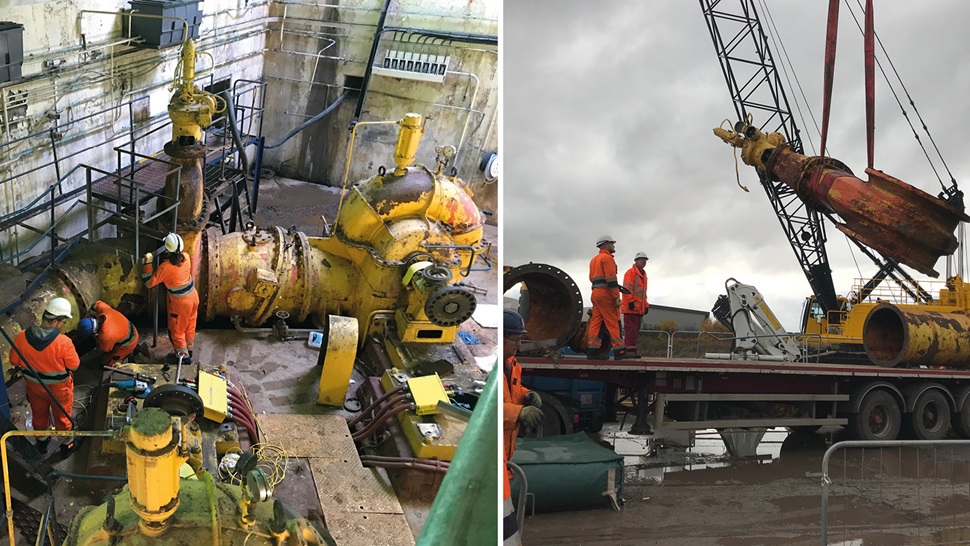
Challenging terrain, logistics, removal, refurbishment and replace of 2 very large valves
Dolgarrog. A site of significant industrial archaeological interest
Dolgarrog is a small village located eight miles south of Conwy on the edge of the Snowdonia National Park in North Wales. It is home to the Surf Snowdonia lagoon, an artificial wave pool built on the site of the former aluminium smelting works which were demolished in 2009.
The smelting works began producing aluminium in 1907 with the furnace powered by a hydro-electric power station. The addition of a rolling mill led to the construction of a larger hydro-electric facility in the early 1920s which is still in operation today*.
The current power station is capable of generating 32MWhr of electricity.
In 1925 the two dams supplying the aluminium works and power station broke their banks, thereafter, this led to the decision to reinforce the control mechanisms within the station. The Glenfield Automatic Self Closing valve was installed in the 1960’s some 40 years after the dam disaster, with the ASC valve uprated in 1989, following the failure of a similar ASC valve at Maentwrog power station.
In 2018, Innogy Renewables UK which operates the Dolgarrog Power Station asked Glenfield Valves Ltd to refurbish both the valves. Site logistics and terrain were a huge challenge and Glenfield Valves worked in a strategic alliance with Franklyn Yates Engineering as its projects partner.

The fundamental hurdle to overcome was that the valves could only be lifted out of the valve house if its roof was completely removed, due to the sheer size of the valves. The valve house itself was only accessible via a steep and winding single-track road. This limited the size of mobile crane that could reach the site to 50 tons. Furthermore, the terrain around the valve house meant the crane had to operate at a 17m radius.
Both the valves were extremely heavy and the bore size of the pipework connecting the valves was 72”, over 1800mm. The weight of the butterfly valve (5.4 tons) was on the limit of the crane’s lifting capacity at 17m radius. The isolating gate valve weighed in at 9 tons and it was therefore decided to dismantle it on site with the valve body left in-situ. The gearbox assembly, bonnet, drive mechanism and other parts were removed for refurbishment.


Open communications with the local population, particularly with those living alongside the access road to the site, were fundamental in ensuring the project ran smoothly. Residents were informed when the escorted loads were being transported down the hill at the start of their journey, to the workshops in Kilmarnock and again when the refurbished valves were returned to site. Franklyn Yates controlled the critical interface between all the project stakeholders including the local population, crane hire company, specialist haulier and the NDT inspection team.
In the Glenfield workshops, the internal component parts of the gate valve were cleaned and shot blasted. Unfortunately, this process revealed that the components were beyond economic repair. The Glenfield team proposed reverse engineering the gate valve to restore it back to its original condition but, after careful consideration, the client decided not to proceed with this option.

The gate valve body remained installed on site at all time where it underwent non-destructive testing to prove its structural integrity. It was then shot blasted, cleaned and painted on site and left in place. According to Jim McAllister, Glenfield Project Manager, the butterfly valve refurbishment was challenging in its own right:
“The butterfly valve is auto self-closing. There is a paddle downstream linked to the valve via hydraulic pistons. When water velocity reaches a certain speed, the paddle triggers the valve’s closing mechanism. Glenfield’s engineers replaced the hydraulic pistons but managed to refurbish and reuse the existing hydraulic unit. The shaft of the butterfly valve was also replaced.”
Project delivered ahead of time.
Due to the critical role of Dolgarrog in power generation the refurbishment contract included strict penalty clauses activated should the project overrun, Glenfield and Franklyn Yates completed the project ahead of time.
Contact Glenfield Valves for more information or to discuss your project.
*The first public electrification in Britain involved the installation of a power line from Dolgarrog power station to Conwy, Colywn Bay and Llandudno.
Contact me, Wilson McPhail at Glenfield Invicta about your project. I can advise on product selection, application and installation. My phone is shown above or click on the email to write to me directly.

